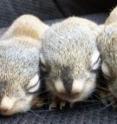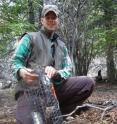When it comes to survival of the fittest, stress is a good thing
When the woods get crowded, female squirrels improve their offspring's odds of survival by ramping up how fast their offspring grow. In a study led by Michigan State University and the University of Guelph (Canada), researchers showed for the first time how females use social cues to correctly prepare their offspring for life outside the nest. The results, published in the current issue of Science, confirm that red squirrel mothers boosted stress hormone production during pregnancy, which increased the size and the chances of survival of their pups.
"Natural selection favors faster-growing offspring, and female red squirrels react accordingly to increase their pups' chances of survival," said Ben Dantzer, formerly with MSU's zoology department and now a postdoctoral researcher at the University of Cambridge (United Kingdom). "Surprisingly, squirrels could produce these faster growing offspring even though they didn't have access to additional food resources."
Proving that food availability isn't always the universal variable affecting population dynamics took a true team effort. It was equal parts field physiology, experimental ecology and longitudinal studies of natural selection that led to these findings, he added.
The team based much of its study on the Kluane Red Squirrel Project, a 22-year-long study on North American red squirrels living in the Yukon led by researchers from the University of Alberta (Canada), Guelph and McGill University (Canada). Out in the field, researchers used recordings of territorial vocalizations, or rattles, to create the illusion of a big population of squirrels.
Females reacted to the increased commotion by producing more stress hormones while pregnant and their pups grew faster. Dantzer, along with Amy Newman of the University of Guelph, also manipulated stress hormone levels in mothers to conclusively show that stress hormones were the cause of the faster growth rates of their pups.
"Despite the widespread perception that being stressed is bad, our study shows that high stress hormone levels in mothers can actually help their offspring," Dantzer said.
The research also showed that these changes were immediate rather than happening over multiple generations, said Andrew McAdam of Guelph University.
"When population density is high, only the fastest-growing offspring survive," said McAdam, who supervised Dantzer when they both were at MSU. "Our study also showed that rather than simply exhibiting lagged responses to environmental changes, the red squirrels may anticipate environmental changes using cues they pick up on during pregnancy."
The squirrels then are able to make adjustments in their offspring, allowing the pups to better survive, he added.
While researchers found that female squirrels could use hormones to help the early survival of their offspring, the pups may not be so lucky in the long-term. Offspring born during these high-density years don't live as long. This suggests that their successful early sprint burns a few matches that would have helped them in the marathon of life.
Additional researchers who contributed to this paper include: Rudy Boonstra, University of Toronto; Rupert Palme, University of Veterinary Medicine (Austria); Stan Boutin, University of Alberta; and Murray Humphries of McGill University.
The research was funded in part by the National Science Foundation.
Source: Michigan State University
Other sources
- How red squirrels can turn into tiger momsfrom MSNBC: ScienceMon, 22 Apr 2013, 18:23:30 UTC
- Image Gallery: Red Squirrel Moms and Babiesfrom Live ScienceFri, 19 Apr 2013, 23:00:34 UTC
- How Red Squirrels Are Like Tiger Momsfrom Live ScienceFri, 19 Apr 2013, 23:00:32 UTC
- Stressed moms give babies a boost, squirrel study suggestsfrom CBC: Technology & ScienceFri, 19 Apr 2013, 17:50:47 UTC
- When it comes to survival of the fittest, stress is a good thing, squirrel study showsfrom Science DailyThu, 18 Apr 2013, 20:01:19 UTC
- When it comes to survival of the fittest, stress is a good thingfrom PhysorgThu, 18 Apr 2013, 18:29:56 UTC

